A) decreasing.
B) increasing.
C) 1 blue scarf.
D) zero.
Correct Answer

verified
Correct Answer
verified
Multiple Choice
Refer to the accompanying table. Corey's opportunity cost of making of a pizza is delivering:
A) 2 pizzas.
B) 3/2 of a pizza.
C) 2/3 of a pizza.
D) 1/2 of a pizza.
Correct Answer

verified
Correct Answer
verified
Multiple Choice
Refer to the accompanying table. ________ has the comparative advantage in making pies and ________ the comparative advantage in making cakes.
A) Martha; Martha
B) Julia; Julia
C) Martha; Julia
D) Julia; Martha
Correct Answer

verified
Correct Answer
verified
Multiple Choice
Suppose Cathy and Lewis work in a bakery making pies and cakes. Suppose it takes Cathy 1.5 hours to make a pie and 1 hour to make a cake, and suppose it takes Lewis 2 hours to make a pie and 1.5 hours to make a cake. Which of the following statements is correct?
A) Cathy has a comparative advantage in pies, and Lewis has an absolute advantage in pies.
B) Cathy has a comparative and absolute advantage in pies.
C) Lewis has a comparative and absolute advantage in pies.
D) Lewis has a comparative advantage in pies, and Cathy has an absolute advantage in pies.
Correct Answer

verified
Correct Answer
verified
Multiple Choice
The fundamental reason firms outsource is that:
A) low-wage workers in other countries are more productive than are U.S. workers.
B) hiring low-wage workers overseas reduces firms' costs.
C) outsourcing increases employment overseas.
D) U.S. workers cannot perform the tasks performed by workers in other countries.
Correct Answer

verified
Correct Answer
verified
Multiple Choice
The United States generally has a comparative advantage in the development of technology because it has:
A) large amounts of natural resources.
B) a disproportionate share of the world's best research universities.
C) the greatest need for new technology.
D) patent laws, which no other country has.
Correct Answer

verified
Correct Answer
verified
Multiple Choice
Moe divides his time between studying Physics and studying Economics. His production possibilities curve for his final grade in each class is shown in the accompanying figure. 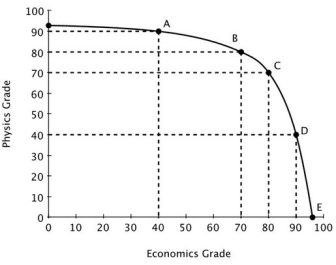 The Principle of Increasing Opportunity Cost is reflected in the fact that the opportunity cost going from 70 to 80 in economics is:
The Principle of Increasing Opportunity Cost is reflected in the fact that the opportunity cost going from 70 to 80 in economics is:
A) lower than the opportunity cost of going from 80 to 90 in economics.
B) higher than the opportunity cost of going from 80 to 90 in economics.
C) lower than the opportunity cost of going from 80 to 90 in physics.
D) the same as the opportunity cost of going from 70 to 80 in physics.
Correct Answer

verified
Correct Answer
verified
Multiple Choice
Refer to the accompanying figure. The opportunity cost of making an additional salad: 
A) remains constant regardless of how many salads are made.
B) increases as the number of salads increases.
C) decreases as the number of pizzas decreases.
D) decreases as the number of salads increases.
Correct Answer

verified
Correct Answer
verified
Multiple Choice
Refer to the accompanying table. ________ has the comparative advantage in making pizza, and ________ has the comparative advantage in delivering pizza.
A) Corey; Corey
B) Pat; Pat
C) Pat; Corey
D) Corey; Pat
Correct Answer

verified
Correct Answer
verified
Multiple Choice
If Ana devotes all her time to making fudge, she can make 3 pounds of fudge an hour, and if she devotes all her time to making toffee, she can make 2 pounds of toffee an hour. If Leo devotes all his time to making fudge, he can make 4 pounds of fudge an hour, and if he devotes all his time to making toffee, he can make 5 pounds of toffee an hour. According to The Principle of Comparative Advantage, Ana and Leo will be able to produce more overall if:
A) Ana specializes in fudge and Leo specializes in toffee.
B) Leo specializes in fudge and Ana specializes in toffee.
C) both Leo and Ana specialize in fudge.
D) the Principle of Comparative Advantage does not hold in this example.
Correct Answer

verified
Correct Answer
verified
Multiple Choice
Lou and Alex live together and share household chores. They like to cook some meals ahead of time and eat leftovers. The accompanying table shows the number of rooms they can each clean and the number of meals they can each cook in an hour. If Alex and Lou work out an efficient arrangement for these two chores, then under that arrangement:
A) Alex and Lou each would do half of the cooking and half of the cleaning.
B) Alex would do all of the cleaning, while Lou would do all the cooking.
C) Lou would do all of the cleaning and all of the cooking.
D) Lou would do all of the cleaning, while Alex would do all of the cooking.
Correct Answer

verified
Correct Answer
verified
Multiple Choice
On a graph of a production possibilities curve, if a point is attainable, then it:
A) must be efficient.
B) might or might not be efficient.
C) is efficient only if it does not exhaust all currently available resources.
D) must completely exhaust all currently available resources.
Correct Answer

verified
Correct Answer
verified
Multiple Choice
An individual has an absolute advantage in producing pizzas if that individual:
A) has a lower opportunity cost of producing pizzas than anyone else.
B) can produce more pizzas in a given amount of time than anyone else.
C) has a higher opportunity cost of producing pizzas than anyone else.
D) charges the lowest price for pizzas.
Correct Answer

verified
Correct Answer
verified
Multiple Choice
Refer to the accompanying figure. For Pat, the opportunity cost of removing one bag of trash is planting:
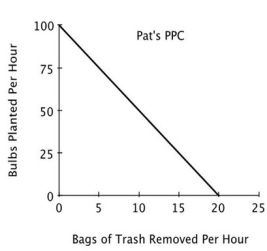
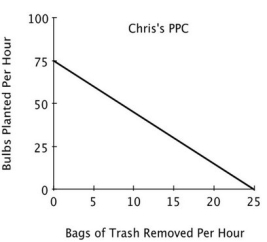
A) 100 bulbs.
B) 5 bulbs.
C) 1/100 of a bulb.
D) 1/5 of a bulb.
Correct Answer

verified
Correct Answer
verified
Multiple Choice
Refer to the accompanying figure. If this restaurant makes 75 salads in one hour, then what's the maximum number of pizzas it can make in that same hour? 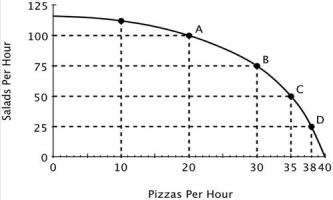
A) 0
B) 10
C) 20
D) 30
Correct Answer

verified
Correct Answer
verified
Multiple Choice
Moe divides his time between studying Physics and studying Economics. His production possibilities curve for his final grade in each class is shown in the accompanying figure.  Both of Moe's professors require at least a 65 to pass and a 90 to earn an A. Which of the following is true?
Both of Moe's professors require at least a 65 to pass and a 90 to earn an A. Which of the following is true?
A) Moe can pass both classes.
B) Moe can pass economics, but only if he fails physics.
C) Moe can pass physics, but only if he fails economics.
D) Moe could earn an A in economics and still pass physics.
Correct Answer

verified
Correct Answer
verified
Multiple Choice
If Les can produce two pairs of pants per hour while Eva can produce one pair per hour, then it must be true that:
A) Les has a comparative advantage in producing pants.
B) Les has an absolute advantage in producing pants.
C) Eva has a comparative advantage in producing pants.
D) Les has both comparative and absolute advantage in producing pants.
Correct Answer

verified
Correct Answer
verified
Multiple Choice
If Al has an absolute advantage over Beth in preparing meals, then:
A) it takes Al more time to prepare a meal than Beth.
B) the problem of scarcity applies to Beth but not to Al.
C) Al's opportunity cost of preparing a meal is lower than is Beth's.
D) Al can prepare more meals in a given time period than Beth.
Correct Answer

verified
Correct Answer
verified
Multiple Choice
Lou and Alex live together and share household chores. They like to cook some meals ahead of time and eat leftovers. The accompanying table shows the number of rooms they can each clean and the number of meals they can each cook in an hour. For Alex, the opportunity cost of cleaning one room is making ________ meal(s) ; for Lou the opportunity cost of cleaning one room is making ________ meal(s) .
A) 4; 4
B) 1; 4/5
C) 1; 5/4
D) 3; 5
Correct Answer

verified
Correct Answer
verified
Multiple Choice
Moe divides his time between studying Physics and studying Economics. His production possibilities curve for his final grade in each class is shown in the accompanying figure. 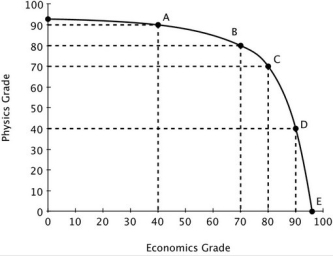 If Moe moves from Point A to point C, his grade in Physics will go down by ________ his grade in economics.
If Moe moves from Point A to point C, his grade in Physics will go down by ________ his grade in economics.
A) less than the increase in
B) more than the increase in
C) more than the decrease in
D) less than the decrease in
Correct Answer

verified
Correct Answer
verified
Showing 61 - 80 of 163
Related Exams